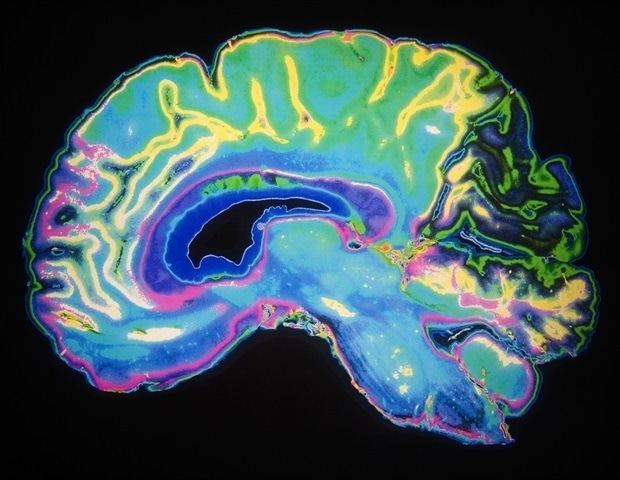Multiple sclerosis (MS) is a chronic autoimmune disease that affects more than 2.9 million people worldwide. This occurs when the immune system mistakenly attacks the myelin sheath, the protective insulation around nerve fibers, causing a disruption of nerve signals between the brain and the body. Symptoms include numbness, tingling, vision loss, and paralysis.
Although current treatments can reduce inflammation, no treatments exist yet that protect neurons or restore damaged myelin sheaths. Researchers have now taken a major step in developing such a treatment with funding from the National Multiple Sclerosis Society. They identified two compounds that have the potential to remyelinate injured axons.
The research, published in the journal Scientific Reports, was led by Seema Tiwari-Woodruff, a professor of biomedical science at the University of California, Riverside School of Medicine, and John Katzenellenbogen, a professor of chemistry at the University of Illinois at Urbana-Champaign (UIUC), and was made possible by two MS Society funding programs: traditional investigator-initiated grants and the society’s Fast Forward commercial. Accelerator program.
Our research represents more than a decade of collaboration, with the past four years focused on identifying and optimizing new drug candidates that show strong potential to treat MS and possibly other neurological diseases involving demyelination. ”
Seema Tiwari-Woodruff, Professor of Biomedical Sciences, University of California, Riverside
The funding enabled the researchers to launch a program licensed from Cadenza Bio, Inc. Subsequent funding from investors has supported Cadenza Bio’s continued development of the program. The company is currently moving toward clinical evaluation as a first-in-class treatment for people living with MS.
From discovery to development
The project builds on previous research on a compound called indazole chloride, which is known to promote remyelination and modulate the immune system in mouse models of MS. While effective, indazole chloride lacked the pharmacological properties and patentability needed for clinical development and commercial investment, Tiwari-Woodruff said.
Tiwari-Woodruff’s research group, led by recent UCR graduate Mika Ferri, screened more than 60 indazole chloride analogs in collaboration with UIUC chemists Katzenellenbogen and Sung-Hoon Kim, who synthesized the compounds. This collaboration identified two lead candidates, K102 and K110, that demonstrated improved safety, efficacy, and drug-like properties in both mouse models and human cells.
Of the two, K102 emerged as the major compound. Researchers found that this not only promotes remyelination, but also modulates immune function, a critical balance for MS treatment. Promising results were also shown in human oligodendrocytes, myelinating cells of the central nervous system derived from induced pluripotent stem cells, suggesting potential translation between animal models and human disease.
Under normal conditions, oligodendrocyte progenitor cells mature into myelin-producing oligodendrocytes to repair damaged myelin. However, in MS, this natural repair process often fails, leading to permanent nerve damage. Successful remyelination with compounds like K102 could restore faster nerve conduction and help reduce long-term disability associated with the disease.
“K110 is also a strong candidate,” Tiwari-Woodruff said. “We are developing it because it has a slightly different effect on the central nervous system and may be better suited for other conditions such as spinal cord injury or traumatic brain injury.”
From bench to biotechnology
Tiwari-Woodruff and Katzenellenbogen believe the National MS Society’s Fast Forward program was a turning point. Fast Forward accelerates the commercialization of promising treatments by fostering partnerships between academia and industry. The highly competitive grant enabled Tiwari-Woodruff and Katzenellenbogen to generate enough data to license the rights to develop K102 and K110 to Cadenza Bio. These patents are jointly owned by UCR and UIUC, and there is an exclusive worldwide license agreement between the two universities and Cadenza Bio.
“This project is a great example of how years of academic collaboration can lead to real-world applications,” Katzenellenbogen said. “Our common goal has always been to take a promising idea and develop it into a treatment that can help people with MS. We are finally getting closer to that reality.”
Initially, UCR’s Office of Technology Partnerships worked with UIUC to seek patent protection. Grace Yee, UCR’s assistant director of technology commercialization, said a joint effort between UCR, UIUC and the National MS Society advocated and promoted the technology to investors and industry for commercial development.
“Our resident entrepreneurs also helped advise the project, allowing the team to develop materials and messaging to highlight the commercial value of the project,” she said. “When investors expressed interest in this technology, UCR and UIUC helped us understand how this technology would address unmet needs in MS treatment. These efforts led to a licensing agreement with Cadenza Bio.”
Elaine Hamm, Cadenza Bio’s chief operating officer, said she and Cadenza Bio co-founder Carol Curtis were impressed by the potential to move from delaying axonal injury to repairing axonal injury.
“This is the future we want to build,” Hamm said. “That’s why we licensed this technology and why we’re excited to bring it to patients who need it.”
Development period of over 10 years
Tiwari-Woodruff and Katzenellenbogen have worked together for more than 12 years. Tiwari-Woodruff’s transfer from UCLA to UCR in 2014 was a pivotal decision, she said.
“The support from UCR has been extraordinary, from leadership to infrastructure,” Tiwari-Woodruff said. “None of this would have been possible without that support. Funding for academic labs like mine and John’s is critical. This is selfless work, driven by a deep love of science and a commitment to human health.”
Although the initial focus is on MS, the research team believes that K102 and K110 could eventually be applied to other diseases that involve neurological damage, such as stroke and neurodegeneration.
Cadenza Bio is currently advancing K102 through the necessary non-clinical studies to support first-in-human clinical trials.
“We hope that clinical trials can begin soon,” said Tiwari-Woodruff. “It’s been a long journey, but translational science is all about turning discoveries into real-world impact.”
This research was supported in part by grants from the National Institutes of Health and Cadenza Bio.
In addition to Tiwari-Woodruff, Katzenellenbogen, Kim, and Feri, Flavio D. Cardenas, Alyssa M. Anderson, Brandon T. Poole, Devang Deshpande, Shane Desfor, Kelley C. Atkinson, Stephanie R. Peterson, Moyinoluwa T. Ajayi, Fernando Beltran, Julio Tapia, and Martin I participated in the study. García Castro of UCR. Kendall W. Nettles and Jerome C. Nwachukwu of the Scripps Research Institute, Florida; David E. Martin and Mr. Curtis of Cadenza Bio, Oklahoma;
sauce:
University of California, Riverside
Reference magazines:
Feri, M., et al. (2025) Chlorindazole-based estrogen receptor β ligand has good pharmacokinetics and promotes functional remyelination and visual recovery. scientific report. doi.org/10.1038/s41598-025-20254-9













